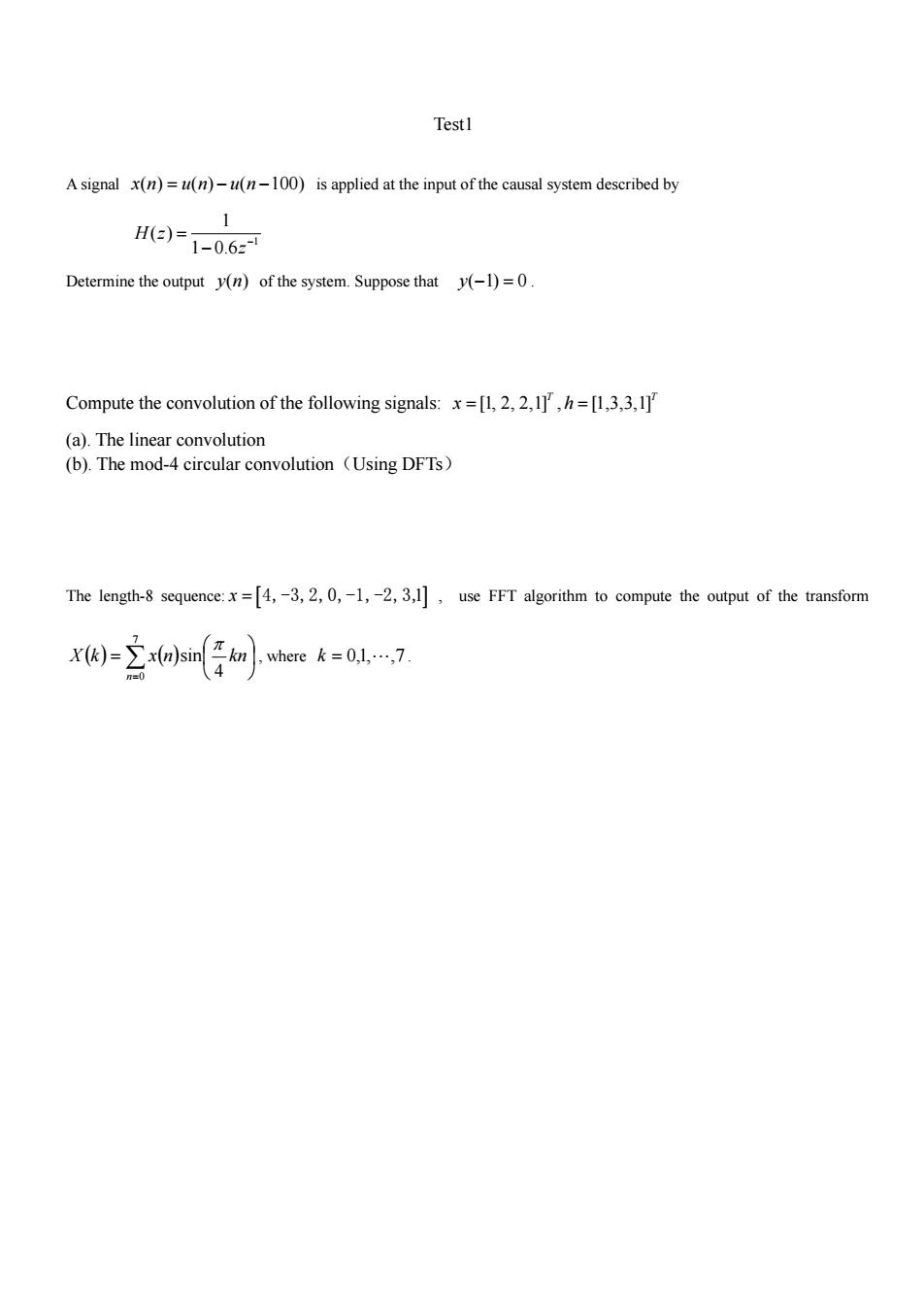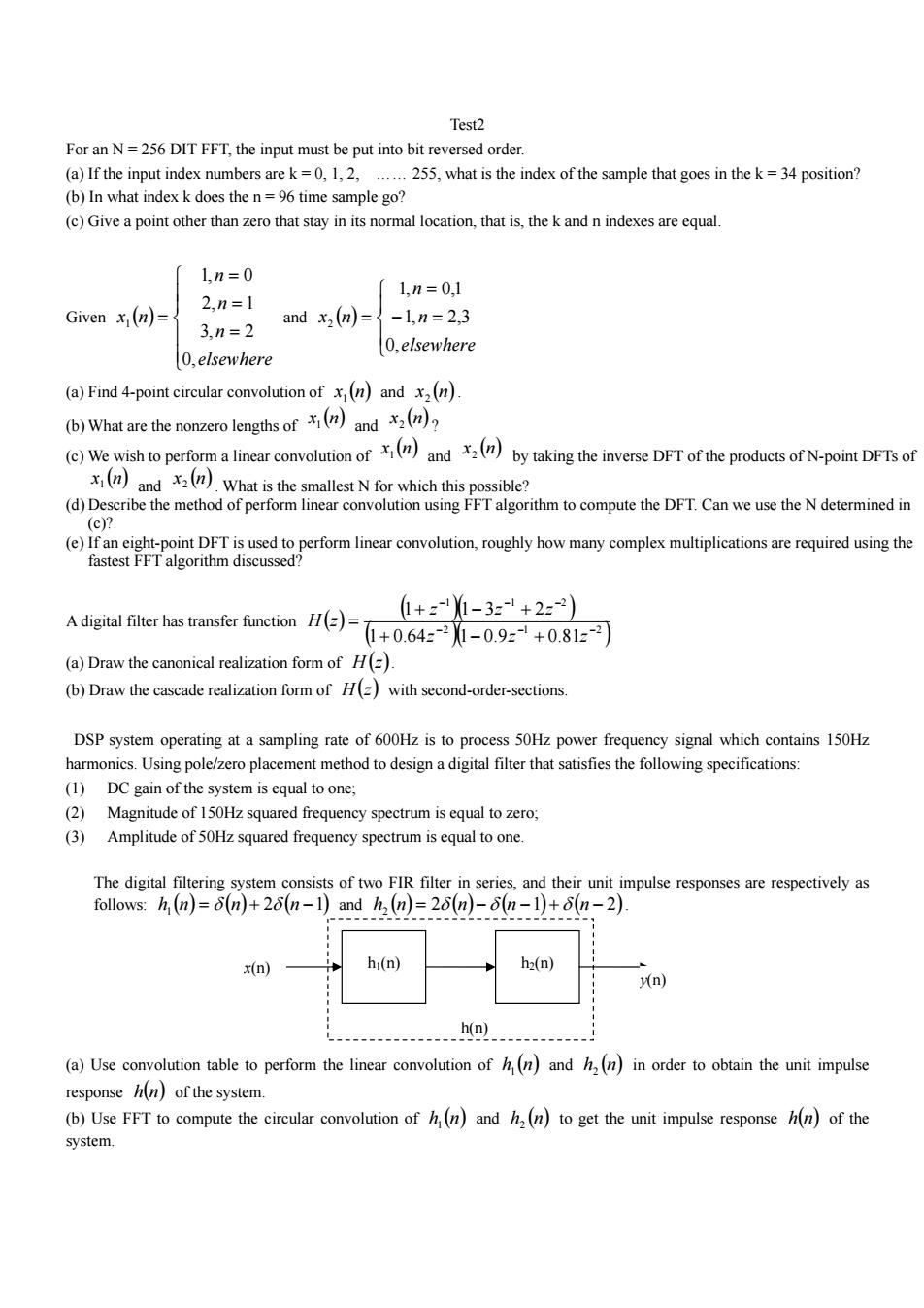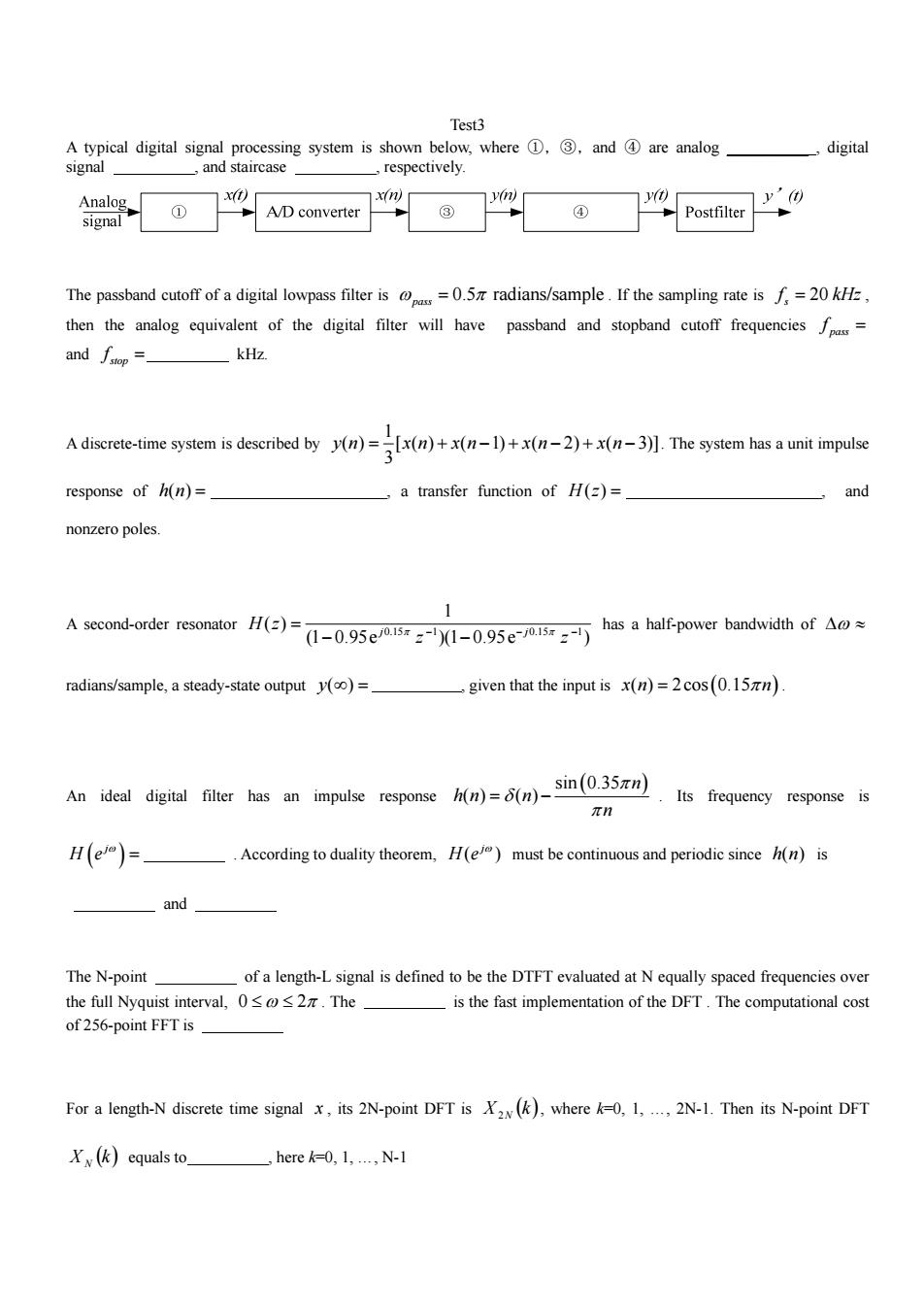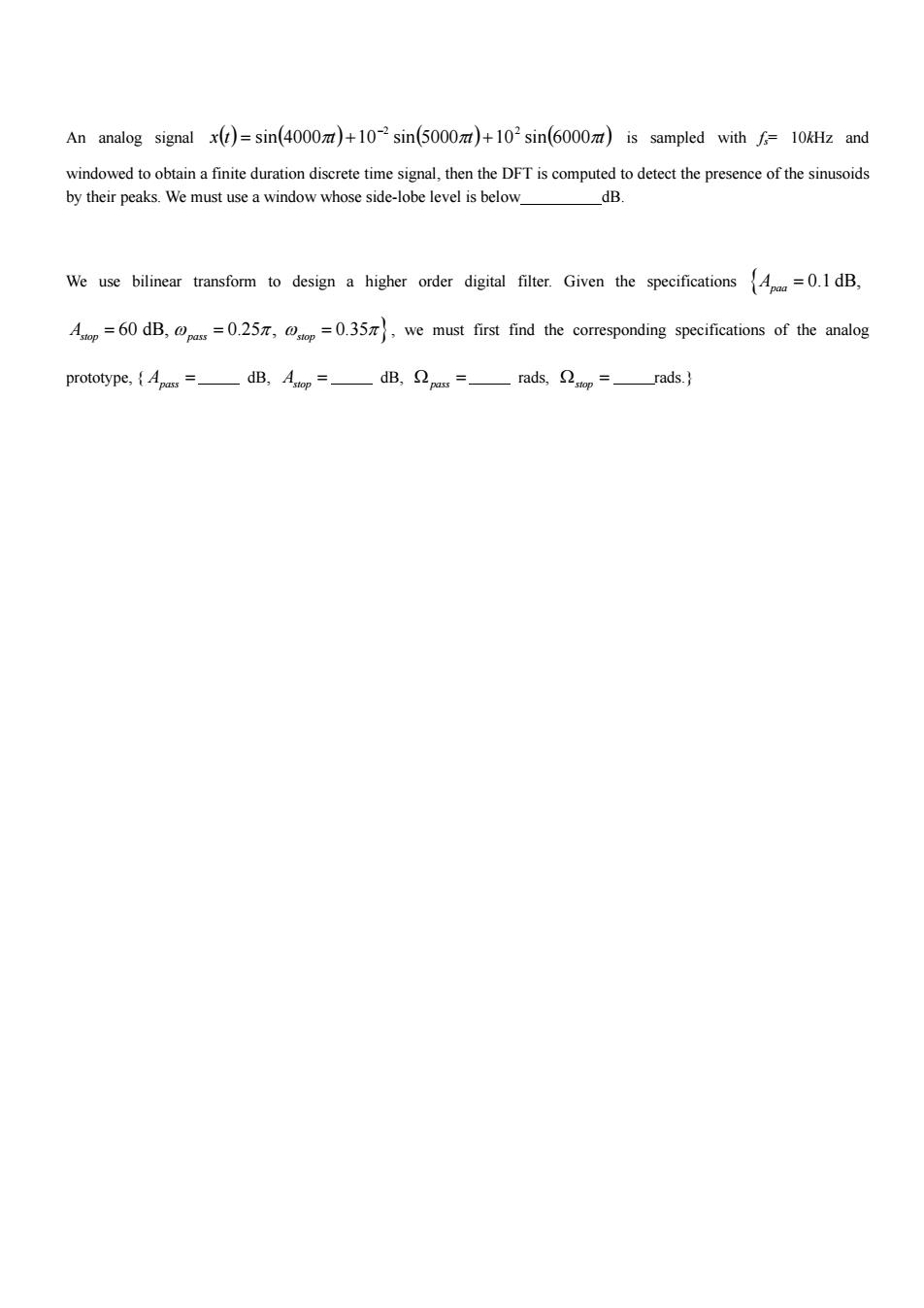
Test1 A signal x(n)=u(n)-u(n-100)is applied at the input of the causal system described by 1 H2)=1-0.62 Determine the output y(n)of the system.Suppose that y(-1)=0. Compute the convolution of the following signals:x=[1,2,2,1],h=[1,3,3,1] (a).The linear convolution (b).The mod-4 circular convolution (Using DFTs) The length-8 sequence:x=4,-3,2,0,-1,-2,3,1,use FFT algorithm to compute the output of the transform x侧)=2sn任tek=0l-7
Test1 A signal xn un un ( ) ( ) ( 100) is applied at the input of the causal system described by 1 1 ( ) 1 0.6 H z z Determine the output y n( ) of the system. Suppose that y( 1) 0 . Compute the convolution of the following signals: [1, 2, 2,1]T x , [1,3,3,1]T h (a). The linear convolution (b). The mod-4 circular convolution(Using DFTs) The length-8 sequence: x 4,-3,2,0,-1,-2,3,1 , use FFT algorithm to compute the output of the transform 7 0 4 sin n X k x n kn , where k 0,1,,7

Test2 For an N=256 DIT FFT,the input must be put into bit reversed order. (a)If the input index numbers are k=0,1,2,.....255,what is the index of the sample that goes in the k=34 position? (b)In what index k does the n=96 time sample go? (c)Give a point other than zero that stay in its normal location,that is,the k and n indexes are equal. 1n=0 1,n=0,1 2,n=1 Given x(n)= and x2 (n)= -1,n=2,3 3,n=2 0,elsewhere 0,elsewhere (a)Find 4-point circular convolution ofx(n)and x,(n) (b)What are the nonzero lengths ofand ()We wishto prformainar onvoution ofandby taking the inverse DFT of the products of N-point DFTs of and.What is the smallest N for which this possible? (d)Describe the method of perform linear convolution using FFT algorithm to compute the DFT.Can we use the N determined in (c)? (e)If an eight-point DFT is used to perform linear convolution,roughly how many complex multiplications are required using the fastest FFT algorithm discussed? Adigital filter has transfer function (1+z-%-3z+2z2) 1+0.64z-21-0.9z+0.8122)) (a)Draw the canonical realization form of H(). (b)Draw the cascade realization form of H(with second-order-sections. DSP system operating at a sampling rate of 600Hz is to process 50Hz power frequency signal which contains 150Hz harmonics.Using pole/zero placement method to design a digital filter that satisfies the following specifications: (1)DC gain of the system is equal to one; (2)Magnitude of 150Hz squared frequency spectrum is equal to zero; (3) Amplitude of 50Hz squared frequency spectrum is equal to one. The digital filtering system consists of two FIR filter in series,and their unit impulse responses are respectively as follows:h (n)=6(n)+26(n-1)and h,(n)=26(n)-6(n-1)+6(n-2). x(n) hi(n) h2(n) wn) h(n) (a)Use convolution table to perform the linear convolution ofn)and h(n)in order to obtain the unit impulse response h(n)of the system. (b)Use FFT to compute the circular convolution of (n)and h(n)to get the unit impulse response h(n)of the system
Test2 For an N = 256 DIT FFT, the input must be put into bit reversed order. (a) If the input index numbers are k = 0, 1, 2, …… 255, what is the index of the sample that goes in the k = 34 position? (b) In what index k does the n = 96 time sample go? (c) Give a point other than zero that stay in its normal location, that is, the k and n indexes are equal. Given elsewhere n n n x n 0, 3, 2 2, 1 1, 0 1 and elsewhere n n x n 0, 1, 2,3 1, 0,1 2 (a) Find 4-point circular convolution of x n 1 and x n 2 . (b) What are the nonzero lengths of x n 1 and x n 2 ? (c) We wish to perform a linear convolution of x n 1 and x n 2 by taking the inverse DFT of the products of N-point DFTs of x n 1 and x n 2 . What is the smallest N for which this possible? (d) Describe the method of perform linear convolution using FFT algorithm to compute the DFT. Can we use the N determined in (c)? (e) If an eight-point DFT is used to perform linear convolution, roughly how many complex multiplications are required using the fastest FFT algorithm discussed? A digital filter has transfer function 2 1 2 1 1 2 1 0.64 1 0.9 0.81 1 1 3 2 z z z z z z H z (a) Draw the canonical realization form of H z . (b) Draw the cascade realization form of H z with second-order-sections. DSP system operating at a sampling rate of 600Hz is to process 50Hz power frequency signal which contains 150Hz harmonics. Using pole/zero placement method to design a digital filter that satisfies the following specifications: (1) DC gain of the system is equal to one; (2) Magnitude of 150Hz squared frequency spectrum is equal to zero; (3) Amplitude of 50Hz squared frequency spectrum is equal to one. The digital filtering system consists of two FIR filter in series, and their unit impulse responses are respectively as follows: 2 1 h1 n n n and 2 1 2 h2 n n n n . (a) Use convolution table to perform the linear convolution of h n 1 and h n 2 in order to obtain the unit impulse response h n of the system. (b) Use FFT to compute the circular convolution of h n 1 and h n 2 to get the unit impulse response hn of the system. h1(n) h2(n) x(n) h(n) y(n)

Test3 A typical digital signal processing system is shown below,where①,③,and④are analog digital signal and staircase respectively. Analog x(t) x(n) m yt) y'(t signal ① A/D converter ③ ④ Postfilter The passband cutoff of a digital lowpass filter is=0.5 radians/sample.If the sampling rate is=20kH, then the analog equivalent of the digital filter will have passband and stopband cutoff frequencies= and fsop= kHz. Adiscrete-time system is deseribed by1)).The system has a unit impulse response of h(n)= a transfer function of H()= and nonzero poles. 1 Asecond-order resonator H((1091 has a half-power bandwidth of△o≈ radians/sample,a steady-state output y(oo)= given that the input is x(n)=2cos(0.15n) An ideal digital filter has an impulse response h(n)=5(n)- in(0.35πn) .Its frequency response is πn H(e)= According to duality theorem,H(e)must be continuous and periodic since h(n)is and The N-point of a length-L signal is defined to be the DTFT evaluated at N equally spaced frequencies over the full Nyquist interval,.O≤o≤2π.The_ is the fast implementation of the DFT.The computational cost of 256-point FFT is For a length-N discrete time signal x,its 2N-point DFT is 2(k),where k=0,1,...,2N-1.Then its N-point DFT Xx(k)equals to ,here k-0,1,...,N-1
Test3 A typical digital signal processing system is shown below, where ①, ③, and ④ are analog __________ , digital signal , and staircase , respectively. The passband cutoff of a digital lowpass filter is 0.5 radians/sample pass . If the sampling rate is 20 sf kHz , then the analog equivalent of the digital filter will have passband and stopband cutoff frequencies pass f and stop f kHz. A discrete-time system is described by 1 ( ) [ ( ) ( 1) ( 2) ( 3)] 3 yn xn xn xn xn . The system has a unit impulse response of h n( ) , a transfer function of H z( ) , and nonzero poles. A second-order resonator 0.15 1 0.15 1 1 ( ) (1 0.95e )(1 0.95e ) H z j j z z has a half-power bandwidth of radians/sample, a steady-state output y( ) , given that the input is x( ) 2cos 0.15 n n . An ideal digital filter has an impulse response sin 0.35 () () n hn n n . Its frequency response is j H e . According to duality theorem, ( ) j H e must be continuous and periodic since h n( ) is and The N-point of a length-L signal is defined to be the DTFT evaluated at N equally spaced frequencies over the full Nyquist interval, 0 2 . The is the fast implementation of the DFT . The computational cost of 256-point FFT is For a length-N discrete time signal x , its 2N-point DFT is X k 2N , where k=0, 1, …, 2N-1. Then its N-point DFT X k N equals to , here k=0, 1, …, N-1

An analog signal x(t)=sin(4000)+102sin(5000z)+102sin(6000m)is sampled with 10kHz and windowed to obtain a finite duration discrete time signal,then the DFT is computed to detect the presence of the sinusoids by their peaks.We must use a window whose side-lobe level is belowdB. We use bilinear transform to design a higher order digital filter.Given the specifications=0.1dB, Ap=60 dB,=0.257,=0.35,we must first find the corresponding specifications of the analog prototype,.{Apas=—dB,Aiop=—dB,2as=—rads,2hop=rads.}
An analog signal x t sin4000t 10 sin5000t 10 sin6000t 2 2 is sampled with fs= 10kHz and windowed to obtain a finite duration discrete time signal, then the DFT is computed to detect the presence of the sinusoids by their peaks. We must use a window whose side-lobe level is below dB. We use bilinear transform to design a higher order digital filter. Given the specifications 0.1 dB, A paa Astop pass stop 60 dB, 0.25 , 0.35 , we must first find the corresponding specifications of the analog prototype, { A pass dB, Astop dB, pass rads, stop rads.}